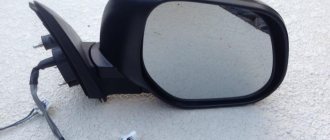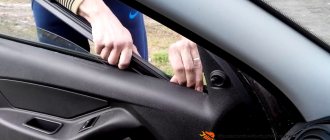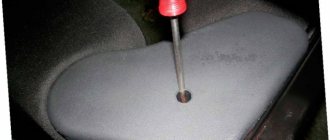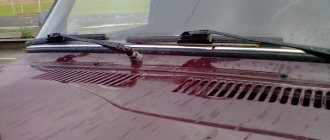A modern comfortable car must have a heated windshield. AvtoVAZ is also trying to produce cars suitable for winter use. The engine can start even in 30-degree frosts. The locks on the doors are also not afraid of the cold. Togliatti engineers included the heated windshield of Vesta in the list of functions.
Not all trim levels are equipped with this option, but only some of them. You will learn how to turn on the heated windshield, its malfunctions, and what versions of the car have it.
How does heated glass work?
- Buttons distribute air flow.
- Starting the air conditioner.
- Air recirculation mode (intake from the cabin or outside).
- Temperature setting.
Vesta's heated windshield is similar in design to other cars. Its button is indicated in the picture in the center and surrounded by a red circle.
This system consists of several parts:
- switch in the cabin;
- in expensive versions of Vesta, a “Defrost Max” button is installed, which, together with heating, activates the air conditioner and maximum air pressure;
- heating filaments inside the windshield, they can only be seen in the sun;
- electrical wiring, relay, fuse link are located under the front panel.
Defrost Max button on the Lada Vesta “Lux” configuration
The “Defrost Max” button activates a relay that supplies current to the filament. As a result, the windshield heats up and thaws away ice and snow.
The system is configured in such a way that after a while the automation turns off the power so as not to waste extra energy.
Device and installation
Heated seats operate on the principle of a heating filament. The calculation is made based on the car's network voltage and the resistance of the heating element. At a voltage of 12 volts, the temperature does not rise above 53 degrees.
The base of the fabric consists of fireproof material. The heating element is made of polymer in fluoroplastic insulation. This provides complete protection against fire. The alloy steel additive provides the heating element with the required strength and flexibility. The service life of the element also increases, which can reach 10 years.
If you buy heated seats separately, the kit will include 2 heating mats and a set of electrical wiring. The mats are installed in car covers in special pockets.
Another installation option is to embed it under the upholstery of a chair. To prevent the heating elements from moving or becoming wrinkled, they must be secured with double-sided tape. Electrical wires are connected to factory connectors designed for such purposes.
Dealers at a car dealership most often agree to install only the original factory kit.
Characteristics
Parameters of the set of heating elements for Vesta seats:
- Power – 55 watts.
- Heating temperature – no more than 53 degrees.
- The operating voltage range is from 12 to 14 volts.
- The resistance of the heating filament is 3.6 Ohms.
- The connection diagram for sets of two seats is parallel.
- Mat size – 280x360 mm.
- Heating time – 2 minutes.
Parameters may differ from actual ones due to constant modernization and refinement of the design.
How to turn on the heated glass on Vesta
There is no separate heating button on regular Vesta trim levels. The heated front window starts working from one button, which is responsible for heating the rear window and side mirrors.
The operation of the system depends on the ambient temperature. If the temperature outside is down to -10 degrees, then heating will quickly melt the icing on the glass. But if it gets colder, the efficiency decreases noticeably. The greater the temperature difference between the cabin and the outside air, the less power the windshield heating is turned on. This is done to prevent the glass from breaking.
To speed up the process of defrosting the windshield, additionally turn on the heater at the highest blowing speed. To prevent fogging, turn on the air conditioner additionally.
Attention! Do not rush to turn on the wipers - they may fail if they do not have time to thaw. Wait until the snow starts rolling down the glass, then you can turn them on.
Peculiarity
Owners of the sedan and crossover drew attention to a technological feature - the heated windshield of the Lada Vesta and Iks Rey cannot be turned on remotely, even if the engine starts automatically. For this reason, many, after remotely starting the engine, even when the power unit is warming up, have to wait until the windshield melts.
On models equipped with air conditioning, this problem is unlikely to occur, since the “climate” unit, after turning off the engine, remembers previously activated functions and also activates them the next time it is started. Therefore, in order not to wait until the glass melts, you just need to remember to turn on its heating, and at the same time the mirrors, before turning off the engine.
As for the versions equipped with air conditioning, there is no memory function. However, as practice shows, it is quite possible to independently connect the heated windshield of a Lada Vesta or X Ray to an additional alarm channel.
If the heated windshield does not work
The effect of the option can be observed in cold weather with frozen glass. If after several minutes you do not see the result, then the glass heating is not working.
The Lada Vesta may have the following causes of malfunction:
- The fuse has blown . Check the integrity of the fuse by its number and location according to the manual. Typically this is a 60 amp fuse number F75. If it is faulty, you will have to replace it with a new one.
- Individual sections of the filament have burned out . It happens that heating does not work completely, but in separate areas. At the same time, you can see on the glass where heating occurs and where it does not. In this case, the windshield will need to be replaced. But many drivers are in no hurry to do this. It's better to drive without heating than to pay for expensive glass. After all, there are no cracks, and nothing interferes with driving the car.
Many Vesta owners, with a valid warranty, contact the car dealership to request repairs. But dealers are trying to convince the car owner that the problem is severe frost. They claim that with a slight warming the function will start working. But it is not always the case.
Dismantling
To connect, first of all, you need to gain access to the SAUKU - the heater and air conditioning control unit. On Vesta and X Ray, the algorithm is different, so it’s worth looking into everything in more detail.
Lada Vesta
In a sedan, the SAUKU unit is traditionally located on the center console. To get to it, you will need to remove 3 elements:
- Panel overlay (plastic);
- Key block;
- SAUKU overlay.
The plastic trim is fixed to the center console using plastic fasteners. To snap them off, you need to pry it at the bottom and pull it towards you.
Next, the panel with the keys is dismantled, which is attached to the clamps, also around the entire perimeter. They need to be snapped off.
The most difficult thing to remove is the SAUKU trim.
It is better to start working on the left side. First you need to get to the fuse box by removing the plastic cover that covers it. You need to turn the 3 plastic handles that secure the lid at the bottom, and then remove the lock from above.
In the end, all that remains is to pull the cover from below, disconnect the clamps that secure it to the device from above, and remove the cover. Once the fuse box cover is removed, you will need to remove 2 mounting screws.
Next, we move on to the central part, where it is also necessary to unscrew the 2 mounting screws, which are located directly under the panel with the keys.
Then all that remains is to unscrew 1 mounting screw on the right side, which is located under the glove box lid.
After this, access opens directly to the SAUKU block, which is attached to the cover plate with Torx screws. They need to be unscrewed and the plug disconnected.
Lada X Ray
Independent connection of a heated windshield on a Lada X-Ray through an additional alarm channel also begins with the removal of the SAUKU unit. Everything here is noticeably simpler than on Vesta. The panel itself with the block is fixed with 2 hooks at the top and 2 iron guides equipped with springs at the bottom.
You need to carefully pry the panel at the bottom and carefully pull it towards you. This will cause the top fasteners to disengage.
In the end, all that remains is to disconnect the plug from the wires.
Which Vestas are heated?
The basic configuration is not equipped with this function. You will find Vesta's heated windshield starting with the "Comfort" version. The minimum price of such a car is 592,000 rubles, and it is constantly being adjusted. Compared to the basic configuration, the difference in cost is about 75 thousand rubles.
If you need this function, but don’t have enough money for an expensive package, you can do it differently. You can install the option after purchasing the car. It will be much cheaper, especially if you install it yourself.
The “luxury” configuration will have “Defrost Max” - the button discussed above. It simultaneously connects rear and front heating, as well as heated side mirrors, air conditioning and air supply.
AvtoVAZ tried to make the Lada Vesta sedan as adaptable to winter conditions as possible. The design of the door locks prevents freezing, and the engine can start even in severe frost (down to -30 degrees). In addition, the manufacturer equipped Vesta with heated windshields, mirrors and seats. Let’s check how well these “warm” Vesta options work in practice.
It’s -20 degrees outside, start the engine and turn on the heater (to blow the windshield and side windows), and also press the button on the panel, which is responsible for:
- heated side mirrors (at the beginning of 2016, AvtoVAZ began installing the “Electric drive and electrically heated exterior mirrors” option on all Vesta trim levels);
- heated rear window;
- heated windshield (optional).
The front seats are equipped with electric heaters, which are activated by a button on the tunnel near the gearshift knob.
Connection
Not all 2180 owners are satisfied with the operation of heating the windshield, rear windows and rear-view mirrors simultaneously with the heater fan and air conditioning. There is one way out of this situation - installing a separate button. Even on Vesta models that do not have a heated windshield function as standard, it is possible to connect this very convenient function when replacing the glass unit. If you need to replace your heated windshield for technical reasons, you should contact an official Lada dealer. Under the guarantee, the procedure is carried out free of charge, after an examination. It is necessary to make sure that replacing the windshield with heating is the only solution to the problem, since not a single part will last better than the original one. Careful operation and compliance with the recommendations of specialists will significantly extend the service life of the heating device. High water pressure on the windshield should be avoided when visiting car washes. Timely replacement of wiper blades is necessary, because poor-quality wipers scratch the glass surface.
Testing heated side mirrors
The heated mirrors began to thaw first, this became noticeable within a minute:
After 3 minutes the ice melted almost completely, and after four minutes the mirror elements were completely dry:
At this moment, the air from the stove is already a little warm, the areas on the side windows near the mirrors and the bottom of the windshield begin to thaw. The rear window heating threads also became clearly visible.
Self-installation
Installing a heated windshield on your own will require knowledge not only of electrical circuits, but also of installing the shield.
To integrate the option you need:
- Remove the old windshield.
- Purchase and install a new one with heating filaments.
- Connect the heating terminals to the power supply.
- Install the relay and button for turning on the heated rear window.
It is important to understand that not all models offer this option. Therefore, installation is only possible if the system is provided for in the design and is installed in high configurations. To install the rear window, you will need to follow the same steps as for the front.
To install the rear window, you will need to follow the same steps as for the front.
Heated injectors and wipers will also require intervention in the car's wiring and the insertion of an additional button.
- remove old cleaners;
- route the wiring according to the diagram from the heated brush kit;
- mount the key into the console;
- connect complete blocks, relays and connectors.
Installing wiring for injectors is no different from installing heated brushes
It is important to select in advance a suitable part with a reliable fastening to the hood cover
Checking the operation of the heated windshield
The efficiency of the windshield heating, like other heating systems in the car, depends on the ambient temperature. Vesta owners have noticed that at -3 degrees, only 3.5 minutes are enough for the ice and snow from the windshield to melt. Then we make one sweep of the wipers and all the ice goes away:
At lower temperatures, for example, when it is -20 degrees outside, the windshield heats up more slowly. Thanks to the heater, after 3-4 minutes the first signs of thawing appeared at the bottom of the glass. The main part of the ice disappears only after 7-10 minutes, you can go.
By the way, if the filaments are clearly visible inside the glass and the heating does not work, contact your dealer with this question; it is possible that this option is simply not activated on your car.
On Lada Vesta SW and Lada Vesta SW Cross, the heated windshield is activated with a separate button. Heating efficiency on video:
3_4
The photo shows the glass after 8 minutes of heating at an outside temperature of -13 degrees. The rear one has become transparent, but on the windshield there is only a narrow embrasure from the heater fan blowing. If you wave the wipers, they will not cause any damage to the ice on the glass. The photo shows the glass after 8 minutes of heating at an outside temperature of -13 degrees. The rear one has become transparent, but on the windshield there is only a narrow embrasure from the heater fan blowing. If you wave the wipers, they will not cause any damage to the ice on the glass.
The photo shows the glass after 8 minutes of heating at an outside temperature of -13 degrees. The rear one has become transparent, but on the windshield there is only a narrow embrasure from the heater fan blowing. If you wave the wipers, they will not cause any damage to the ice on the glass.
However, electronic diagnostics revealed some errors, and they were erased from memory. So far the frosts have receded, so I can’t say anything about changes in the heating operation yet. Taking this opportunity, I would like to ask the owners of Russian cars and foreign cars with a warm windshield: how efficiently does it heat up in yours?
Lada Vesta from ZR park: going for service
Defrost MAX mode
On luxury Vestas with air conditioning, the “Defrost MAX” mode appears. It allows you to most effectively clean all windows and exterior rear-view mirrors from fogging, freezing or icing. To enable this mode, you need to press the corresponding button (No. 24) on the climate control unit.
When the mode is activated, the air conditioning (if conditions permit), electric heating of the windshield and rear windows, as well as side mirrors will be forcibly turned on. The entire air flow is directed to the blower nozzles of the windshield and front side windows, and the maximum air speed and temperature are also set.
Control unit for ventilation and heating system with air conditioning (manual control)
- The air supply mode is regulated by pressing buttons numbered 11 – 16, the indicator light lights up.
- To cool the incoming air, press button No. 18.
- The minimum air temperature depends on the “degree” of the air outside, the angle of the sun’s rays, the fan rotation speed, the active recirculation mode, and the speed of movement.
- After turning on the air conditioner (separate button No. 18), the indicator light comes on. Cooled air enters the car interior, and the humidity decreases sharply.
Before activating the air conditioning system, be sure to start the car engine. Do not allow the “cooler” to operate when the outside air temperature is below 5°C.
- During operation of the air conditioner, moisture and condensation will accumulate under the bottom of the car on the asphalt. Don't worry, this is a natural process.
- Before starting the air conditioning system (hereinafter - AC), be sure to make sure that at least one or more deflectors on the dashboard are in the open position. Otherwise, the air ducts will freeze up and the air conditioner will fail.
- It is strictly forbidden to direct a flow of cold air onto the windshield or side windows. This will lead to freezing and fogging.
- Do not direct the air flow towards the body, limbs of the driver or passengers.
An active air conditioner takes 5–7% of power from the power unit, and also increases fuel consumption by 3–5%. The indicator values are averaged; the higher the speed, the greater the consumption. When driving in mountainous areas or serpentines, the SC can be deactivated automatically, as the load on the motor increases several times.
Results
In severe frost (at -20 degrees), the thawing order will be approximately as follows:
- 1 minute - the ice on the mirrors begins to melt;
- 2.5 minutes - the ice on the mirrors has almost melted, the bottom of the windshield (stove) begins to thaw;
- 4 minutes - the mirror elements are completely dry, the snow on the threads of the rear window will melt;
- 5-6 minutes - the windshield and areas on the side windows near the mirrors noticeably move away from the ice;
- 7-8 minutes - the heating has melted the ice from the main part of all the windows, you can drive.
In warmer weather, you can start driving earlier, as soon as the engine speed drops to operating speed. There are no comments on the operation of Vesta’s heating; one can only find fault with the fact that the seat heating is not adjustable.
Let us remind you that a discussion of the reasons why Vesta does not start well in cold weather or why the engine does not start at all is not included in this article. Other reviews and tests are in this category. Leave feedback on the operation of the heaters in the comments to the article.
How to turn on the heated windshield
The design of the system is in many ways identical to foreign analogues, namely: second generation Renault Logan, Renault Duster, Ford, Renault Clio.
The mode is activated by pressing one mechanical button, which is installed in the center of the dashboard at the bottom. One function key is responsible for heating the front, rear, and side windows.
In the maximum configuration, Lada Vesta is equipped with a “Defrost MAX” button. When pressed, it starts the maximum speed mode of the stove heater, heating, and air conditioning system. This is extremely necessary to prevent fogging and reduced visibility.
Causes of heating malfunction on Lada Vesta
Recently, we have heard frequent complaints from motorists that when the button is activated, the windshield heating does not work. Do not rush to go to a workshop for diagnostics. Common reasons:
- Ambient temperature. As soon as the temperature drops below -15°C, the system becomes unstable. This is a defect at the software level, not just your car model.
- Damage to the protective layer and insulation also negatively affects the functioning of the system. Check the wiring first with a multimeter, most likely there is a loose contact on the board.
- When the temperature readings are down to -15°C, the delayed start mode is 3-4 minutes, warming up lasts 15 – 20 minutes. If the thermometer readings are lower, then the time increases to 5 - 8 and 20 - 30 minutes, respectively.
- Burnt fuse. Check its integrity in the mounting block, serial number No. F35, F38.
- Burnout of individual filament circuits: it is impossible to restore the functionality of the unit, only replacing it with a new one.
- Code violations in the stock firmware of the electronic engine control unit (ECU). Contact official dealers to update the data.
Reviews
| № | Positive |
| 1. | Stepan , 44 years old (www.otzovik.com): the heated mirrors on the Lada Vesta work as normal. There is a delay during activation, but it does not exceed 1 – 2 minutes. |
| 2. | Fedor , 40 years old (www.zr.ru): up to 15 degrees with a minus mark, the heater copes at all “100”. When the temperature is low, I additionally activate the stove heater. |
| 3. | Vladimir , 22 years old (www.autobann.su): heated side mirrors do not cover the entire perimeter of the glass, layers remain at the edges. I use a plastic spatula. |
| 4. | Sergey , 33 years old (www.lada-vesta.net): the “Defrost MAX” system is effective only at a temperature of minus 10 - 15°, no more. In severe frosts, I additionally activate the stove heater; the system does not independently cope with the assigned task. |
| 5. | Semyon , 43 years old (www.otzovik.com): delay when turning on 2 - 3 minutes. This is an average, it is different for everyone, I have already inquired from the official dealer. |
| 6. | Svyatoslav , 44 years old (www.zr.ru): my positive review of the heating system, it is quite effective and functional, unlike previous modifications. |
| 7. | Mikhailovich , 20 years old (www.autobann.su): I won’t praise the heating, it doesn’t work at full capacity, it allows for “gaps”. In severe frost I activate the heater fan. |
| 8. | Anatoly , 43 years old (www.lada-vesta.net): a full cycle of warming up the windshield and rear window takes 10 - 15 minutes. I was interested in my comrades, they have a similar period of time. |
| 9. | Gennadievich , 39 years old (www.otzovik.com): a good system, but the heating of the rear window is insufficient; in severe frost, gaps are visible on the glass. |
| 10. | Dmitrievich , 43 years old (www.zr.ru): in two years of operation, I once replaced the fuse responsible for the operation of the stove heater and windshield wipers. |
| 11. | Konstantin , 35 years old (www.autobann.su): the heating system is good, I don’t use it often. The heating on the side windows is insufficient. |
| Negative | |
| 12. | Victor , 44 years old (www.zr.ru): I won’t praise “heating”, since it is effective only down to -5 – 7°C. In severe frost, the filament does not heat, the power is insufficient. |
| 13. | Alexey , 37 years old (www.otzovik.com): after the winter, the system began to work unstably, with periodic failures. I contacted the workshop and they said that the equipment needed to be replaced. |
| 14. | Stepan Ignatievich , 46 years old (www.autobann.su): unlike the Lada Vesta, the heating system is better implemented in the second generation Renault Logan. |










